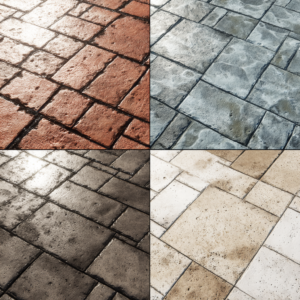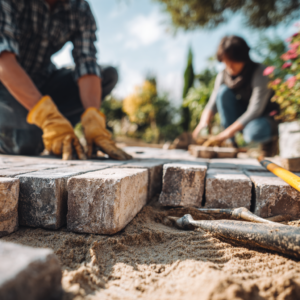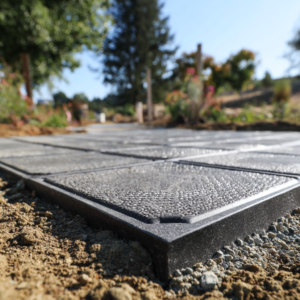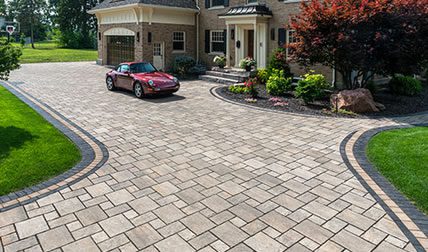
Hardscape projects are never as simple as they seem. Even though pavers are extremely popular at the moment, stamped concrete is still an option for many homeowners. At some point, you might face yourself between the stamped concrete vs pavers battle.
When that happens, before you make a choice, you need to know the pros and cons of each one, their cost benefit, and all the ins and outs of it when it comes to installation and maintenance.
The goal of this article is to present you with all this information and talk about some of the questions involving that choice. Hopefully, by the end, we will have clarified some of your questions and help you have a better idea of what you want for your project.
Jump to:
Stamped Concrete vs Pavers: What is the Difference?
First of all, you have some options for materials when it comes to pavers: from natural stone and brick to concrete and porcelain, there’s no right or wrong choice. In that regard, it all comes down to the characteristics of your project and your personal preferences.
Each of these materials has its own features, pros, and cons, so we highly recommend you research carefully and ask for the help of a professional before deciding which material you want for your project.
To make things simple for this analysis, we are going to use for comparison the type of paver that is the closest thing to stamped concrete: the concrete paver.
Stamped concrete and concrete pavers are actually the same thing, just in slightly different forms.
These pavers are made with the same ingredients as concrete, albeit with a little adjustment in proportion.
The difference is that pavers go through a specialized machine where that concrete is pressed and molded, creating a very sturdy block of concrete. So sturdy, in fact, that it ends up being around three times stronger than regular concrete.
With some adjustments, depending on the manufacturer, the ingredients of concrete are usually sharp sand, stone chips, cement powder, water, and pigment, with the later addition of special products to help with the curing of the product and the reduction of efflorescence.
So now you know that when you’re making the choice between stamped concrete and pavers, you are not deciding between two different materials. You are choosing what version of the same material better suits your needs.
Stamped Concrete vs Pavers: Appearance and Design
In that category, pavers get a head start. They are considered by professionals in the field to be the most beautiful hardscape material you can acquire. Pavers can come in a wide variety of colors and textures.
However, stamped concrete gets prepared on-site, something many people consider an advantage since it can have its color adjusted to match perfectly with the vision you have for your project.
That goes for the pattern as well. The “stamp” of your stamped concrete can be, within reason, anything you want.
Stamping consists in making marks in the concrete after it has been poured, but before it completely dries. So you can imagine how you have a lot more creative freedom to create any kind of pattern that you want.
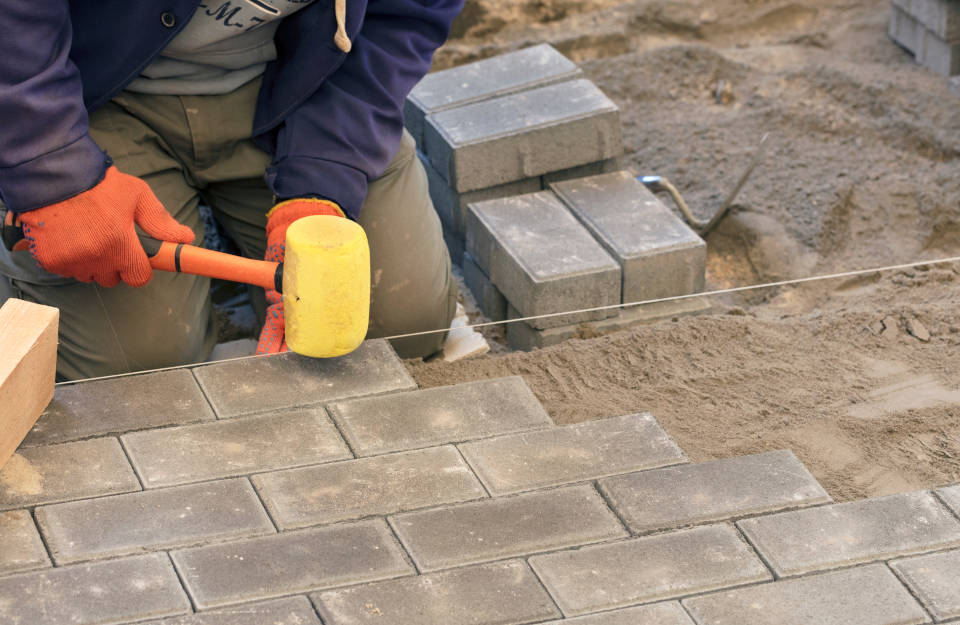
So, even though you have many choices of colors, formats, and textures for pavers, it still doesn’t beat the highly custom potential of stamped concrete.
Stamped Concrete vs Pavers: Durability and Repair
Again, pavers start ahead here. They are extremely low maintenance, requiring only an eventual wash and sweep.
Pavers also, as we mentioned before, are three times stronger than stamped concrete and have more water absorption. They can even be permeable, which completely prevents floods and water puddles.
Concrete, however, has a big problem dealing with heavy objects. They are, for example, a big no-no for driveways, as they will certainly crack after a while due to the weight of the cars that go through them.
You also need to invest way more time and money in the maintenance of concrete – and even then, it will eventually lose its color and pattern over the years.
Repairing concrete is also a complicated process.
If for some reason your concrete patio gets damaged, stained, or cracked (and concrete will crack over time, be aware of that), you need to hire a contractor to patch the concrete, if the damage is small, or, in the most damaged cases, even cut a whole area around the damage to fix the problem.
Forget about matching colors, too, since the new concrete will be new and the color of the old one would have already faded away.
On the other hand, repairing pavers is a very simple process: as simple as taking the damaged blocks and replacing them with new ones. And since they are way more resistant, you don’t even need to worry too much about damaging them in the first place.
Installation
Stamped concrete needs to be cut with what professionals call “control joints” in order to control the cracking.
These joints act as an attempt to give some flexibility to the final product and they depend on the overall shape of the terrain where it is poured.
They end up disrupting the pattern of the concrete, sometimes making the entire project aesthetically unpleasant.
Pavers however are naturally flexible, and the seams between each block are incorporated in the design of the project.
Also, pavers have room to “move”. That is important in expansive soils and harsh weather conditions. The very difficulty of concrete to move is what prompts its problematic crackling.
Final Score
Pavers are, by a wide margin, the clear winner.
The only upside of stamped concrete is that you can personalize it as much as you want. Sometimes, though, it is not worth it to make that trade for the high durability and low-cost maintenance of pavers. Pavers require a little more initial investment, but they easily pay themselves over time.
In the end, you should always ask for professional help to make that choice. And if you’re in the Sarasota area, JS Brick is your best choice.
Open Monday to Saturday, from 8 AM to 5 PM, give us a call at +1 941 586 9140. We’ll be happy to help you with installation, supply, and maintenance of all your hardscape needs.
FAQ
Even though it’s popular for its cost, stamped concrete is not considered the best investment when it comes to hardscape, as it presents many disadvantages.
It will crack eventually, within a year or so, there’s no way around it. It is produced on-site (which comes with some advantages), but quality control is a nightmare, as it is almost impossible to create two mixtures with the exact same color and quality.
Also, it is not very resistant, neither to weather effects or everyday usage. It is not recommended for driveways, for example.
Comparing costs in hardscape is always complicated. Hardscape projects are an investment, and they should be treated as such.
From an upfront perspective, yes, pavers are more expensive. But from a long-term perspective, they are much cheaper than stamped concrete. They can last for decades with a fraction of the time and money you would have to invest in the maintenance of stamped concrete.
Yes, they very much do. Stamped concrete can add up to 15%, while concrete pavers have been known to add up to 35%.
Yes, it does. Both stamped concrete and concrete pavers, actually.
Sealing is an important step of the hardscape process that can greatly alter the resistance and lifetime of your installation.
No. The ground in which pavers will be placed requires preparation for what we call a dry installation, which consists of a bedding of road base and sand.

